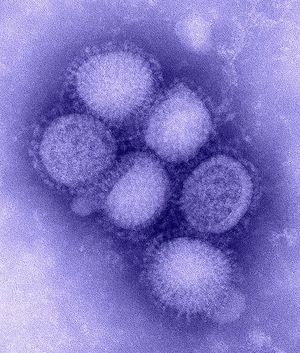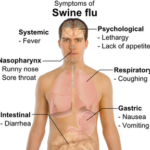In early June of 2009 the World Health Organization moved the alert level to phase 6, triggering the official declaration of the first pandemic since 1968. As fall begins in the northern hemisphere, preparations are underway to protect North Americans against a new flu season in which both seasonal flu and the H1N1 swine flu are expected to make their presence felt.
H1N1 History
The 1918 Spanish flu was caused by an avian strain of influenza A subtype H1N1. It is thought to have infected approximately one third of the world population, killing millions. In contrast to most influenza epidemics, it affected mostly healthy adults rather than the young, the old and the ill. This is thought to be the result of the body overreacting to the virus, a phenomenon called a cytokene storm. Healthy adults with strong immune systems had stronger reactions to the virus than populations normally affected by influenza. (“1918 flu pandemic”) Cytokene storms are also related to SARS and avian flu (H5N1,) and may be implicated in the 2009 H1N1 pandemic. (“Cytokene storm”)
A further H1N1 epidemic occurred in the Soviet Union in 1977-78. In this instance the virus affected mostly people under the age of 23, probably because there had been a similar strain present from 1947-1957 and people alive during that time would have developed some immunity. Influenza A/USSR/90/77 was incorporated into the 1978-79 influenza vaccine. (“Influenza A virus subtype H1N1”)
Recent Developments
Original concerns over swine flu emphasized not only the unusual vulnerability of otherwise healthy adults, and there were concerns about the possible death tolls we could expect this fall as flu season comes around again. Despite some of the similarities to the Spanish flu, this strain of H1N1 apparently has a death rate closer to that of seasonal influenza. (“Swine flu death rate similar to seasonal flu: expert”) Regardless of this good news, research continues and action plans are being prepared in many countries.
Preparation includes production and testing of vaccines, as well as plans to acquire and distribute the vaccine to those who are most likely to be affected. Along with a redefinition of what constitutes an influenza epidemic, there are also measures in place to help fight transmission of flu in schools and day-cares. Information packets are available for workplace managers. Health care workers are calling for better protection through the use of fit-tested N-95 respirators for personnel who care for influenza patients, rather than surgical masks which may not prevent against airborne transmission.
The CDC is recommending that for high-risk patients a plan of action be developed that may include prescription by telephone if the individual develops symptoms of influenza. Anti-virals such as Tamiflu are most effective if administered within 48 hours of the onset of symptoms, so it is important patients at highest risk for complications get the medication promptly. (“Revised CDC guidance on flu antivirals stresses early treatment”)
“One-Shot” Vaccine
Although originally anticipated to require two injections, the H1N1 vaccine has proven to be effective with only one dose if boosted with a adjuvant. Supplies are being tested for safety, and are expected to be available for distribution in Canada and the United States in the fall.
Both countries are aiming at targeting the people most at risk for earliest vaccination. These include pregnant women and people under 65 who have a chronic illness. Students and younger children who attend daycare are also among those for whom the vaccine is recommended, as viruses tend to spread more in groups that remain in close contact. Health care workers, first responders and caregivers of those at risk are also being targeted. (“Government of Canada issues guidance on H1N1 influenza vaccine sequencing,” “2009 H1N1 vaccination recommendations”)
Speak to your health provider for more details. H1N1 vaccines will be available wherever you would normally be vaccinated. In some areas free vaccination will be provided, or programs will be set up through schools and other facilities.
It is recommended that those who get the H1N1 vaccine also plan to take the seasonal flu shot, as the two vaccines provide protection against different strains of influenza.
Is It Flu?
Symptoms of swine flu include coughing and fever, runny nose, sore throat and chills. There may be muscle or joint pain, or headache. In some cases there may also be diarrhea or vomiting. (“2009 flu pandemic”) Those at risk for complications, or those who feel very ill, should seek medical attention. Most others will get well on their own.
Prevention of Spread
As influenza is caused by a virus the best course of action is to practice good hygiene, including frequent handwashing with mild soap, and covering up coughs and sneezes. Avoid the use of antibacterial agents, as they will not kill viruses. Vaccination is recommended over the use of masks, avoiding social contact and cancelling public events. (“Studies suggest novel H1N1 patients shed virus longer”)
Although self-isolation was originally recommended, doctors now feel the effects of the virus are milder than feared, and it is spreading too rapidly for isolation to be very effective. Additionally, infected people are probably shedding virus before they have any symptoms. (“Studies suggest novel H1N1 patients shed virus longer”)
Doctors now recommend anyone with flu-like symptoms stay home while they have fever and for 24 hours after they have a normal temperature without using fever-reducing medications. Like seasonal influenza, H1N1 can last between seven and ten days. H1N1 virus seems to be shed slightly longer than seasonal flu, but it is unclear whether the amount shed near the end of the illness is enough to infect another person. Virus is shed in larger quantities towards the beginning of the illness. (“Studies suggest novel H1N1 patients shed virus longer”)
Sources:
“1918 flu pandemic” Wikipedia
“2009 flu pandemic” Wikipedia
“2009 H1N1 vaccination recommendations” Centers for Disease Control and Prevention
“Body bags included in reserves’ flu package, chiefs say” The Province (CanWest)
“Cytokene storm” Wikipedia
“Government of Canada issues guidance on H1N1 influenza vaccine sequencing” Public Health Agency of Canada
“H1N1 and seasonal flu: multiple doses, many questions” USA Today
“Influenza A virus subtype H1N1” Wikipedia
An open letter to New York State Commissioner of Health Richard F. Daines and administrators of healthcare facilities/agencies in New York State” NYS Nurses Association
“Revised CDC guidance on flu antivirals stresses early treatment” CIDRAP
“Studies suggest novel H1N1 patients shed virus longer” CIDRAP
“Swine flu death rate similar to seasonal flu: expert” (Reuters)
Reference:
- Mapping spread of H1N1 in the USA – will be updated regularly www.cdc.gov/h1n1flu/update.htm
- Mapping spread of H1N1 in Canada – will be updated as new figures are reported www.leaderpost.com/health/swine-flu/Swine+Mapping+H1N1+outbreak+Canada/1565858/story.
- Alberta doctors to get extra pay if province dclares state of emergency, nurses outraged www.theprovince.com/health/swine-flu/Extra+fees+treating+patients+outrageous/1919851/







